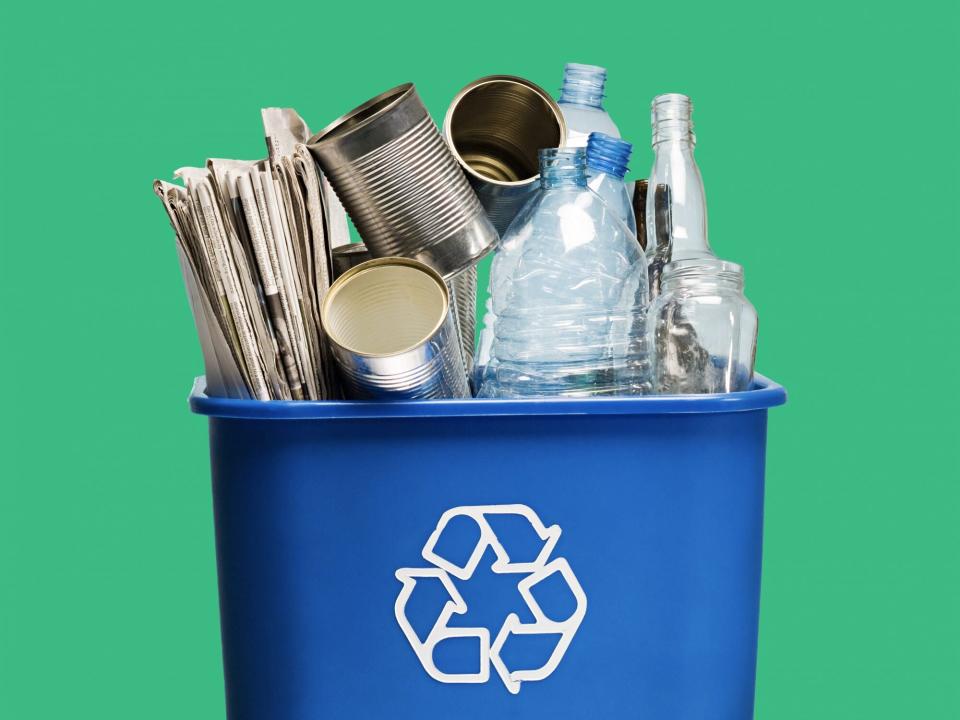These Are the Best and Worst States at Recycling (and Why), According to This Study
It's no secret that the United States' recycling system is far from perfect, largely due to insufficient government surveillance, varying state rules, and low consumer recycling education. As a result, within the same country there are striking disparities: take that of Maine's 72 percent recycling rate and West Virginia's recycling rate of only 2 percent.
Environmental consultancy agency Eunomia released a first-of-its kind study in collaboration with Ball Corporation, presenting a comparative state-by-state assessment of recycling rates for common containers and packaging materials (CCPM), including plastic, cardboard, glass bottles and jars, aluminum, and steel cans. The results aren't all that shocking: Overall, our recycling habits are in poor shape.
RELATED: 'Wishcycling' Could Be Hurting Your Recycling Efforts—Here's How to Fix It
For the study, Eunomia, a U.K.-based, independent research company, assessed the 2018 across-board recycling rates for CCPM to determine production, recycling, and disposal rates on a pound per-capita basis. These are the most recent research results available stateside. And with the booming online shopping culture only amplified by the pandemic, it's likely these findings have been exacerbated in the past year.

Getty Images
RELATED: These 8 "Sustainable" Habits Aren't as Green as You Might Think—Here's How to Fix Them
Maine Has the Highest Recycling Rate in the U.S.
Whether it's due to nature tourism or the proximity to Canada (which, FYI, does way better than we do at recycling), Maine wins the recycling race, according to data in the "50 States of Recycling" report, with a whopping 72 percent recycling rate. Other states included in the top 10 include Vermont, Massachusetts, Connecticut, New York, New Jersey, Oregon, Minnesota, and Michigan. Of the 10 states with the highest recycling rates for PET bottles and aluminum cans (PET stands for polyethylene terephthalate—a recyclable material) nine of them have a "bottle bill" and curbside recycling infrastructure. A "bottle bill" is another name for container deposit law or deposit-return system (DRS). A bottle bill "requires a minimum refundable deposit on beer, soft drink, and other beverage containers in order to ensure a high rate of recycling or reuse," according to BottleBill.org.
Additionally, "eight of the top 10 recycling states have some of the highest landfill disposal costs on a per ton basis," says Sara Axelrod, director of sustainability at Ball Corporation. "Policymakers must combine smart recycling and waste management policy such as DRS, landfill bans, EPR (extended producer responsibility), or disposal costs with investment in local infrastructure to support a system that incentivizes real circularity."
In essence, governmental agencies in these top-recycling states have a more robust handle on their recycling initiatives, thus influencing both consumers and businesses to recycle.
West Virginia Has the Lowest Recycling Rate in the U.S.
A sweep of the southernmost border of the U.S. reveals the country's worst states at recycling, including, in diminishing order: New Mexico, Texas, Alabama, Oklahoma, Mississippi, South Carolina, Tennessee, Alaska (the odd one out, regionally), Louisiana, and West Virginia. West Virginia closes out the round with 2 percent recycling rate.
However, the report was not intended to single out states, but rather to showcase our recycling system in an objective light. It's a snapshot that confirms, according to Axelrod, that the U.S. recycling framework needs improvements.
"Recycling policies and infrastructure vary greatly across states and municipalities; we don't have a common system to measure recycling performance; and recycling as a whole has been underfunded," she says. "It's no surprise that many people are confused about what and how to recycle," Indeed, when it comes to recycling systems, there's no common ground across the country as a whole. The recycling system was created in the 1950s and slightly revised in the 1980s. In the context of the volume of consumerism we see today, the discrepancies and deficiencies are no surprise.
RELATED: 6 Recycling Mistakes You're Guilty of—and How to Fix Them
The Conclusion? Policy and Infrastructure Needs to Change
The study was published just following the renewed discussion behind the Break Free From Plastic Pollution Act, which aims to reform America's insufficient recycling system by reducing the amount of wasteful plastic produced and shift the burden of waste management on corporations producing it. Axelrod agrees that "policy and infrastructure that work together will drive success at both the state and national level." However, "enhanced consumer [education and] adoption—understanding what materials are truly recyclable, and how to recycle them—is critical to make a real impact," she adds. "At an institutional level, we're doing our job right if we make everyday recycling easy for consumers everywhere."
Today, only 25 percent of U.S. waste is recycled, and it's up to us as consumers, as well as policymakers, corporations, and government agencies, to both diminish waste and improve recycling regulations to respect planetary boundaries.
RELATED: 10 Smart Ways to Reduce Your Carbon Footprint in the Kitchen (and Save on Your Energy Bill)

 Yahoo Movies
Yahoo Movies 
